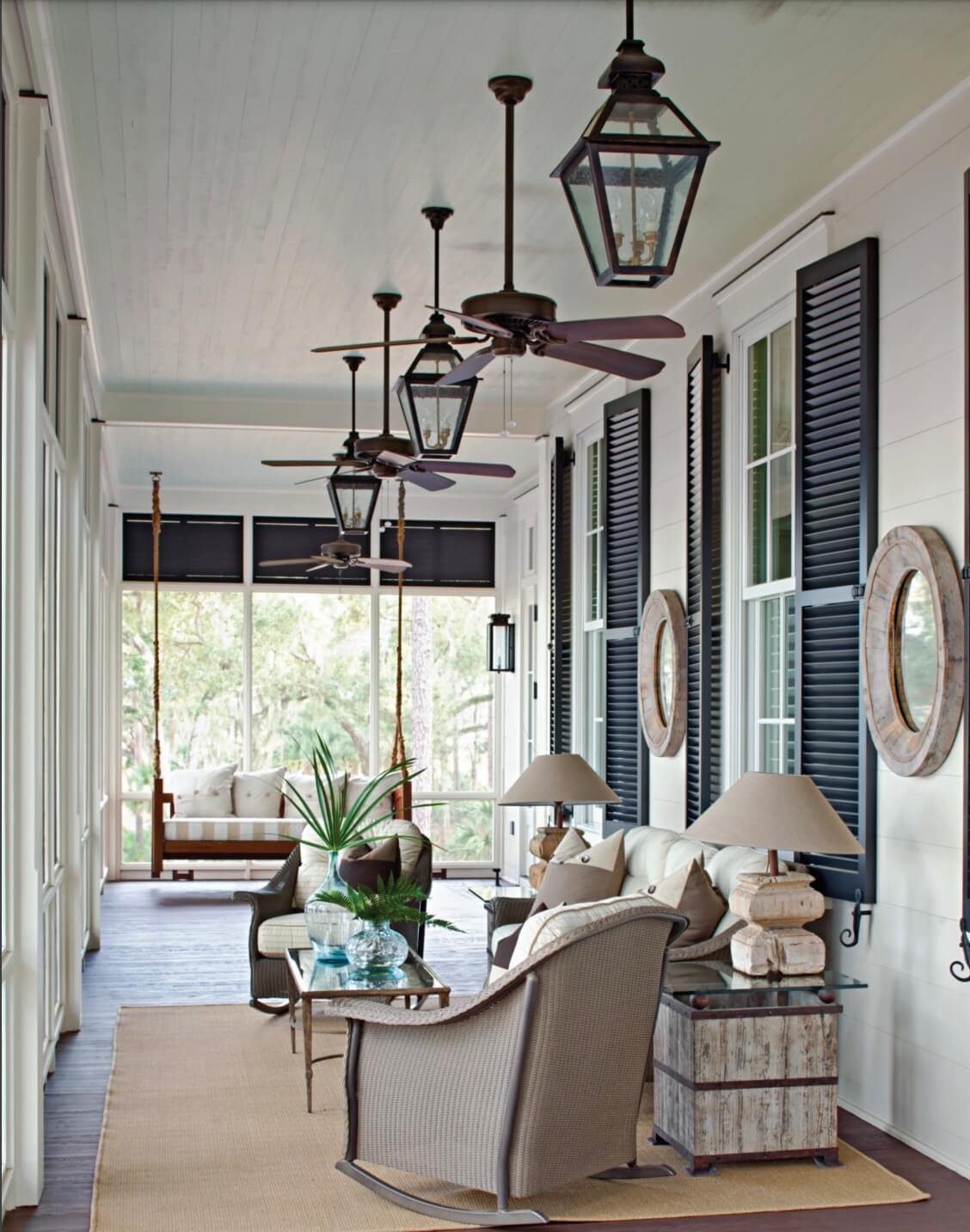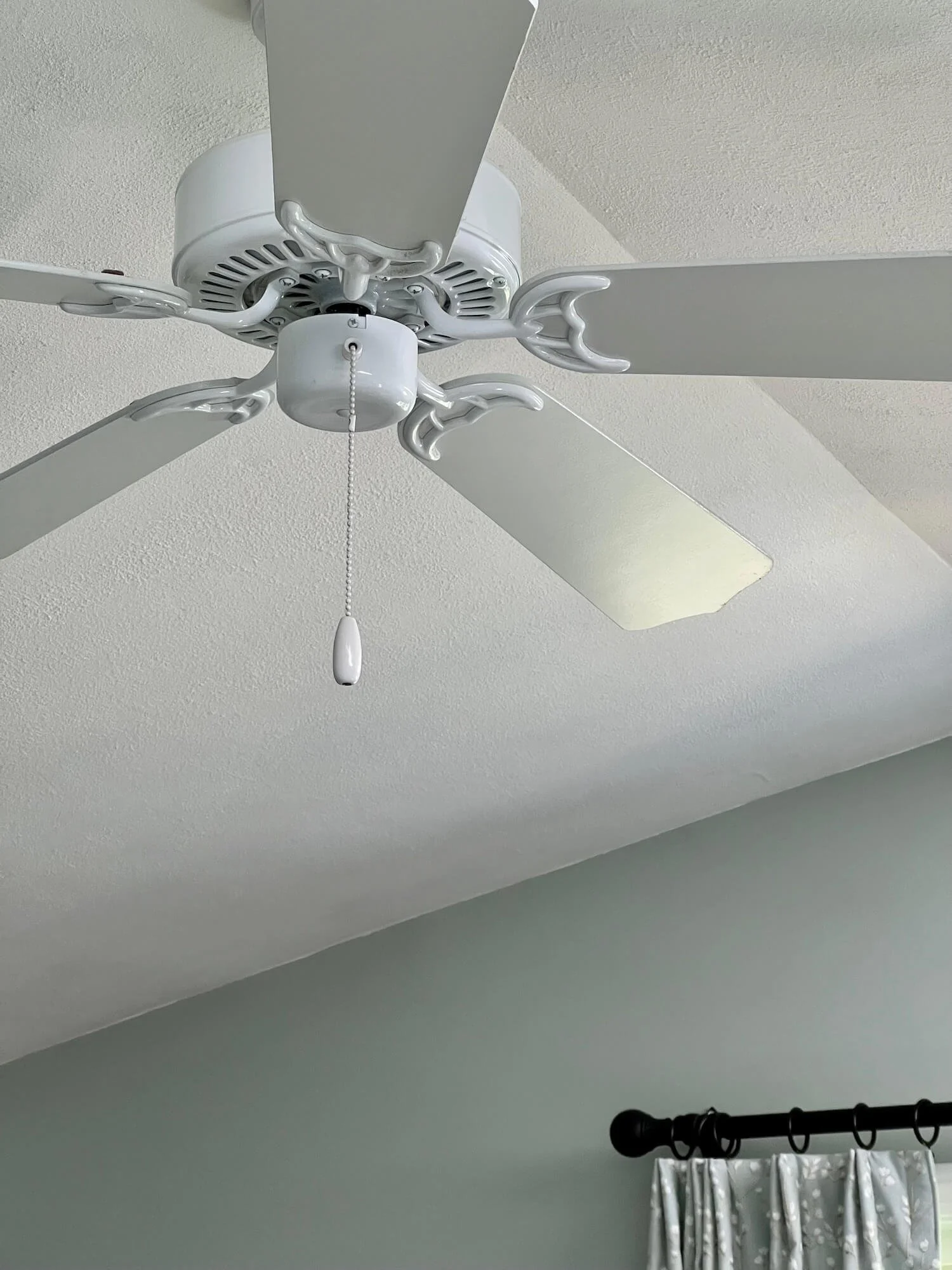Much controversy rages in the interior design industry over ceiling fans. Some designers abhor them and always want them gone…and some concede they are necessary and sometimes even desirable.
Sometimes the divide is akin to the war between the states (or the wahr of nahr-thern aggression if you are from the south!). Those who live in steamier climates see them as a necessity, northerners see little point in them.
Those of us in the frozen north are just grateful to see temps going up at this time of year…until they go up too much and THEN we start complaining too. Basically we are happy with the weather here about 4 weeks out of 52 (but they are 4 GLORIOUS weeks 🤣).
Anyway, back to ceiling fans.
A VERY Brief History of Ceiling Fans
The idea of ceiling fans has been around since 17th century India when fans made from palm leaves or cloth were suspended from the ceiling and operated by a servant pulling a cord.
Belt-driven steam powered ceiling fans appeared in the US around 1860. And in 1882 Philip Diehl, who worker for the Singer Sewing Machine Co. invented an electric ceiling fan that used a sewing machine motor.
Original ceiling fans were two-bladed. Four blade versions appeared around WW1. By 1920, ceiling fans were commercially available and quite popular, especially in warmer climates.
SO yes, of course there is a time and place for ceiling fans, but there are guidelines for using them tastefully.
Please note: this post contains affiliate links meaning I may make a small commission on any purchases at no additional cost to you.
The 3 Commandments for Buying Ceiling Fans
Typical common ceiling fan. And 99% of the reason ceiling fans have a bad design reputation.
1.) A ceiling fan is for moving air - it should not also have a light. Ceiling lights are a design element that provide illumination. Aside from the fact that they both attach to a ceiling, these two things have no common purpose - I don’t know who started this combo, but PLEASE, avoid this frankenmonster if at all possible.
THIS is one of the reasons ceiling fans are so maligned - they are often badly combined with either an interrogation lamp built into the hub or some awkward dangly globe(s) with a vaguely Victorian or Tuscan sensibility. Manufacturers, PLEASE STOP this!
If you need a light, hang a light, if you need a fan hang a fan. Stop trying to make an all-purpose ceiling appliance. It’s like making a toaster that is also a coffee maker - I mean you could…they both plug in and go on the counter…but why would you?
I know there are fandeliers (a mash up of chandelier and fan-in-a-cage). I maintain these are relatively useless for either purpose, so I think they are a trend without much staying power, but if you love a fandelier, you do you!
2.) Unless it is a decorative design element in its own right, the ceiling fan should fade into the background. Choose all white for a white ceiling.
3.) Be sure a decorative fan that is attention-grabbing is an appropriate style and scale for the space. It should not be ditsy in a large space (or worse, have sprouted a bunch of tiny offspring in the same room). And it should not be so overly large that it looks menacing - like it’s plotting to decapitate the occupants.
Dragon wing fan blades….creative? yes. But there are a limited number of spaces where Jurassic Park decor is appropriate . Image via Etsy
Fan Functionality
A ceiling fan will be rated with the volume of air it moves and the speed at which it moves that air. The speed at which the air is moving is the important piece for producing the cooling wind chill effect that makes a fan promote a perceived lower temperature.
Most ceiling fans have a switch to reverse direction. Counterclockwise motion creates a downdraft which is useful for cooling in the summer, clockwise creates an updraft for circulating warmer air in the winter (a slower speed is called for in this case so you don’t also produce an incidental breeze).
Nautical turquoise sail ceiling fan. Image via Tropical Fan Co. Fan available HERE
Fan Size and Placement
The speed and volume at which fans move air is determined by the size and angle of the blades and the speed of the motor. A larger fan does not necessarily equal more cooling power. CFM, the cubic feet per minute number on the box, can be misleading because a larger fan will move more air than a smaller one, but not necessarily at a faster wind speed.
The column of air right below the fan and about 2 or 3 feet beyond will be most affected, so a larger fan impacts a larger area, but needs a more powerful motor to move at the same speed and provide the same cooling effect as a smaller fan with the same or lower CFM.
For vaulted or tall ceilings you will need a fan with a down rod stem to get the breeze closer to the action. Fans should never be hung closer than 84” from the floor, but as close to that as possible will maximize the effectiveness of the fan.
Just be aware, the longer the stem, the more vibration and noise is likely at high speeds.
Fan Noise
Out of balance fans will be unnecessarily noisy. If your fan gets noisy over time or starts vibrating more than usual, clean the blades and inspect the screws that hold them on to see if any are loose. If none of that solves the problem, fan weights that attach to the top of the blades can be used to restore balance.
Where to Use a Ceiling Fan
Not every room calls for a ceiling fan, but they can be useful and attractive in several instances.
The prevalence of air conditioning has made the necessity of ceiling fans indoors much less necessary, but as a decorative element, adding ceiling fans can lend a bit of a “summer vacation” tropical vibe.
A palmetto leaf fan lends a tropical air to this room. Image via Hinkley. Fan available HERE
Porch ceilings are ideal spots for ceiling fans. Nothing says lazy summer lounging like a covered porch with a ceiling fan whirling. And you can’t air condition the great outdoors, so a fan is really the only option for cooling an outdoor room!
Modern sculptural fans lend a breeze for comfortable sleeping in this vacation home bedroom. Image via Kichler. Fan available HERE
In homes without AC, a ceiling fan over a bed or seating area can be a godsend! I don’t have central air conditioning and I have a ceiling fan over my bed. It is SO lovely to have moving air for the handful of nights that are oppressively hot and sticky.
Here is a selection of stylish ceiling fans. Most are available in a variety of finishes and colors. (Click on letter and name in the caption/legend below this image for links and info)
A Classic Cyclone | B Windmill | C Kyte | D Link | E Aspen | F Tropic | G Aviation | H Nautical
As in all things, I am a fan (haha) of classic style. Fans can be classically modern, or classically retro, or classically old fashioned. Just choose the right one for your space!










